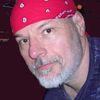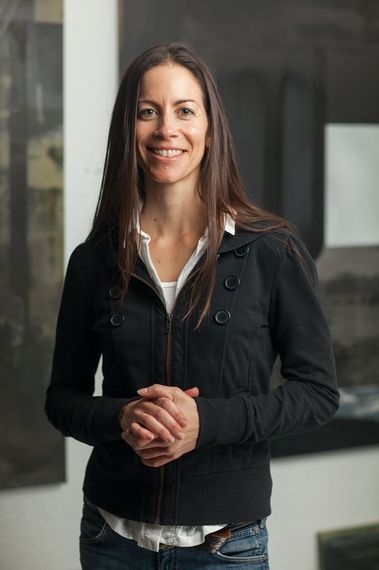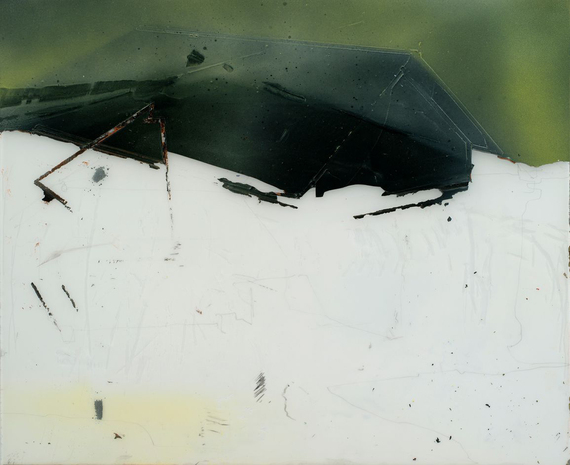
Michelle Mackey, Dirt Jetty, 14" x 16", latex and gouache on duralar, 2013. Photo via John Berens (all images courtesy of the artist)
This is the third of a series of interviews that focus on Local 829's Scenic Artists, the "behind the scenes" talent who sculpt and paint in a variety of ways, the sets we see on television and in movies and documentaries, on theater stages and in the backgrounds of television and internet commercials.
I first met Michelle Mackey about a year ago while working on the set of Manhattan Love Story, a short-lived ABC romantic comedy. It was immediately apparent that Mackey was most pleased when we were creating a series of abstract paintings for the show's primary loft set. Soon, I would discover her greatest passion, her art, and the unique way in which she lives her life splitting her time between Brooklyn, NY, as a scenic artist, and Dallas, Texas, where she teaches painting at the University of Texas at Dallas. Mackey has representation in Dallas, Texas with Holly Johnson Gallery, as well as Eugene Binder Gallery in Marfa, Texas. She is also a contributing writer for ArtCritical.com and culturecatch.com.
Recently, I had the opportunity to ask Mackey a few questions about her art with the hopes of unraveling the layers of mystery in her complex and compelling visions.
DDL: Even though your abstraction has its roots in the here and now there is a definite otherworldliness to the work. In one of the settings of your works, Telescoping (2012), it looks as though it is being lit by the harshly imposing lights of an inquisitive alien space craft eerily illuminating an almost unnaturally darkened space. Then there are what looks to be the stencil/compressed air and paint works from your Berlin Stories series that seem to be comprised of memory flashes that are burned onto the far reaches of your subconscious thoughts and impressions that are plucked and prodded for renewed analysis. The characteristics of these works, and the others like them seem to be suggesting something of a spiritual nature. Can you elaborate on your intentions?
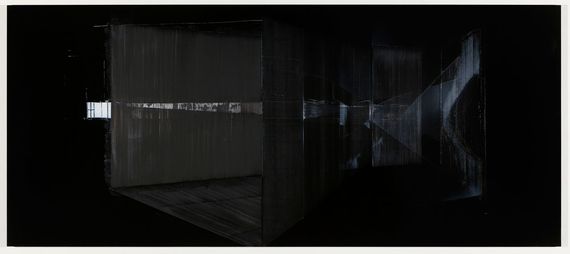
Michelle Mackey, Telescoping, 43" x 95" x 1", Primer and clear coats on resin-coated wood, 2012. Photo via Kevin Todora.
MM: Images "burned onto" my subconscious are exactly what I'm considering, as well as other influences "behind the scenes." In Telescoping, I was thinking of light and it's power to confuse what we might take for granted, like when a bright light seems to obliterate the tangible materials around it. Shaky footing allows me to reconsider what I think I know, so I set-up these architectural spaces that have an unnatural glow or something dimensionally unclear. Your mention of the alien spacecraft is interesting because I'm very aware of surveillance and the question of who is being watched and through what lens. My understanding of reality has less to do with cause and effect and more with interactions and influence. For many years I researched Quantum Mechanics (as a novice): The idea that particles behave differently on the sub-atomic level than in the observable world and that the act of observing changes the behavior of the observed is mystifying and exciting to me. As for my spiritual background, I grew up in the church, so the realm of the unseen spiritual world interacting and affecting the physical world and vice-versa is familiar territory. To this day, my faith provides me with the most complex questions.
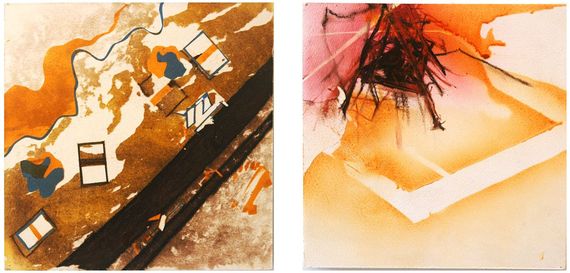
Michelle Mackey, (left) Sand Box Plan, 10" x 10", acrylic, oil pastel and ink on paper, 2007, (right) Jungle Gym Violet, 10" x 10", acrylic, oil pastel and ink on paper, 2007. Photo via Michelle Mackey
In 2007, I traveled to Berlin for a solo exhibition and I stayed there for five weeks. I created the Berlin Stories series from memory upon my return to NY. In Berlin, I would take daily walks in a park shaped like an extruded rectangle with a slight hill along one side. Atop this hill were solitary swings separated from one another by at least 20 feet. At the base of the hill were a few basketball nets and a monumental piece of playground equipment comprised of large, splintery logs in the shape of a ship. Even with the recreational equipment, the park seemed more reflective than jubilant. It wasn't until the end of my trip that I discovered the history of this park -- it used to be part of the "death strip" that led to the Berlin Wall. This "death strip" formerly contained raked gravel, dogs and watchtowers, whereas now it has grass, picnics and basketballs. Needless to say, these contradictory layers intrigued me and my Berlin Stories exhibition was based on this park. I seem to have a radar for places where the history cannot be totally subverted or re-contextualized. I have responded to many sites like this in my work: an abandoned train station in Detroit and the gas station that belonged to Clyde Barrow's parents (of Bonnie and Clyde fame). These sites have a collective memory as well as individual histories that are buried in the spaces themselves -- within the architecture, the walls, the ground and the empty spaces. Sometimes what is buried or hidden needs to be recognized -- so, I'm probing the unseen through the seen.
DDL: I'm a big believer in the collective unconscious. I also think artists, because they are always searching and observing, are more aware of the 'buried histories' you have experienced at the "death strip". It's a very powerful allure. You can't help but have anticipation that the unknown will become "familiar" in a sense -- something that incubates during the process of responding, filtering, creating. I wonder, do you feel any connection to individual artists? In some of your earlier works such as Honeycomb and Surround, both from 2002, I see that there might be a link to the thinking of Juan Gris.
MM: Yes! the "unkown becoming familiar" -- well put, Dominick. The collective unconscious certainly plays a role in the allure and the understanding of the buried history/memory. Artists are receivers as well as creators. Good call on the link to Juan Gris -- I was heavily influenced by the cubists and specifically Braque during the early 2000s. Some contemporary painters whose work has influenced me over the years: Dana Schutz, Tom Nozkowski, Michael Williams, Pat Steir, Katy Moran, Jacqueline Humphries and the list is ever -- shifting. But, in the last two years, I can narrow down two vital influences: I saw Las Meninas in person and was emotionally overwhelmed. After being dumbstruck, I spent several hours drawing from Velazquez. And, the second major influence is film noir -- the lighting, the shadows, the interior shots. I have watched a lot of 40s movies.
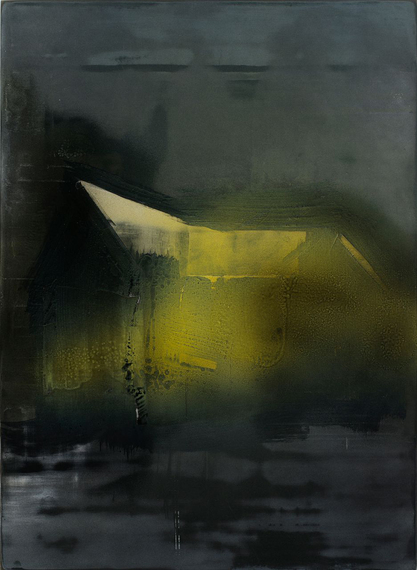
Michelle Mackey, Canary Noir, 23" x 32", latex enamel and shellac on masonite, 2013. Photo via John Berens
DDL: I know the feeling, being emotionally overwhelmed by great art. I'll never forget, when in Venice in 1980 I saw Titian, Tintoretto and Tiepolo in the city where they were painted -- the atmosphere, the setting, the color, the brush strokes, the inventiveness and the beauty -- I was overwhelmed -- I wept, actually, just for a moment. It's one of the greatest aspects of art; it's ability to move us. The film noir connection is curious. I wonder if the fact that you work on sets as a scenic artist, and the whole thing with the drama in film noir, the acute camera angles, the haunting mood of the films is what comes through in a good amount of your work. Is that sensitivity you are picking up and transferring into paint spawned or enhanced in part by your film work -- your exposure to how believability is created with texture, paint, lighting and dressing in what are essentially forged environments?
MM: Yes! I absolutely think my scenic work has heavily influenced my interest in the power of fake/real environments. As you know well, as scenics, we suggest real situations through manipulating certain materials to look old or new or weathered. Or, we manipulate wood to look like marble, etc. When our work as scenics is lit on the sound stage, we see what the camera sees and what it can't see... and I still get a kick out of that. When all the heavy lighting equipment is set up for a filming day -- the intensity of the scene under the lights is amazing... and it transforms when you see it through the lens. It is still magic for me. In film noir, light and shadow has such a pronounced role due to the sharp angles of the lights and the camera. Light and shadow creates the characters for me. The piece I wrote for Culture Catch recently focuses on The Third Man and specifically the role of these visual geometries. When I was a kid, our family would watch old black and white movies -- The Thin Man series, Hitchcock, and other classics, so my sensitivity to high contrast and value tones started early. Typically, I can't remember the narrative of these films, but the feel of the film is what I take with me.
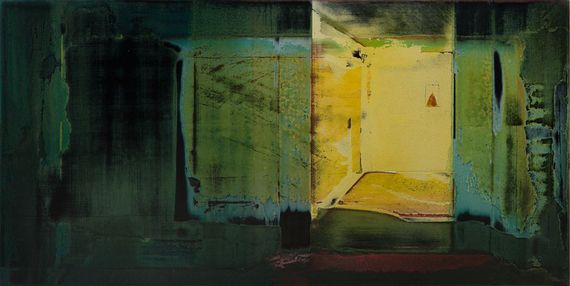
Michelle Mackey, Alcázar, 11"x 22", latex enamel, shellac and joint compound on wood panel, 2014. Photo via Kevin Todora.
DDL: Overall, you have a lot going on in your art that is tactile. The texture of the surfaces you create with joint compound, the slickness of the shellac in contrast to the rougher surfaces, and what looks to be some sanding back or wet wipe-offs into previous layers and applications all comes together in a dance of thoughts and images. The works are very close to the way a sculptor would both add to and reduce her/his surfaces. I guess what I am saying is, the work looks and feels very physical; it's as if the viewer can imagine you twisting and circling around as you create. Is there sculpture in your past or maybe in your future?
MM: I like to approach the work in a physical way -- when I teach, I tell my students to stand and not sit in front of their painting. I tell them that it's like fencing -- they need to be in a ready stance. This conversation of art takes "readiness." I don't have much sculpture-making in my background beyond some ceramics and stone carving classes in undergrad, but, I do want this very physical presence to my work. I believe this desire for physicality comes from my constant study of surface in Brooklyn over the last 17 years. In grad school, I wrote a poem called "Surface is the Truth of Substance" which I read aloud in a coffee shop "open mic night" with my head down in barely a whisper because I was shy and pretty scared. I've lost that poem, thankfully, but the title says it all. I want this physicality to be present, not as a simulation of some heavy material, more as "a dance of thoughts and images" as you so eloquently put.

Michelle Mackey, Half Light, 11" x 22", latex enamel, shellac and joint compound on wood panel, 2014. Photo via Kevin Todora.
DDL: Before we end our conversation I wanted to take one last look at the most intriguing aspect of your paintings, the content. As Kandinsky once wrote " The inner spirit of art only uses the outer form of any particular period as a stepping-stone to further expression." With that in mind, there's a palpable sense of transference -- maybe multi-dimensionally -- definitely spatial transference -- especially in the Afterglow series and the Anamnesis series where the settings and imagery suggests a different kind of transitioning. I'm wondering if you are suggesting something like an out-of-body experience or spiritual enlightenment, even earth to something beyond as some suggest is experienced at the moment of death. Are you representing this or a similar type of shift in the aforementioned works without revealing anything too concrete or limiting. Am I in the ball park?
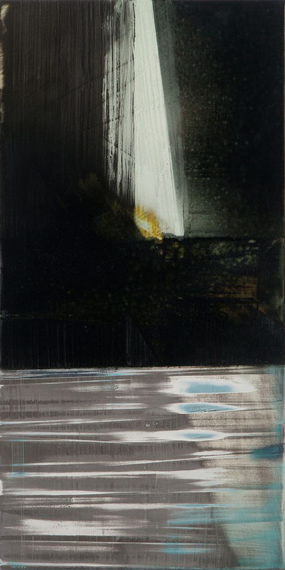
Michelle Mackey, Rhythmic Blue, 22" x 11", latex enamel and joint compound on wood panels, 2014. Photo via Kevin Todora.
MM: You are in the ballpark, Dominick.
I do believe in an afterlife, but these paintings are very much about the present.
Two weeks ago, I asked myself a question in my sketchbook about the light in the Anamnesis series; it's similar to what I think you're asking now, so I'll reprint it here:
'What kind of light comes through? lingering, fading, foreboding, signaling radioactive afterglow, thermographic, illuminating...'
I am placing the viewer on the threshold of an odd and demanding space/ place.
I really want discovery. Maybe these paintings are a series of elaborate questions.
Currently, Michelle Mackey has a selection of her latest mixed media paintings in a group exhibition titled Back & Forth: Celebrating 10 Years at the Holly Johnson Gallery, which is located at 1845 Levee Street #100, Dallas, Texas 75207. Gallery Hours are 11 to 5, Tuesday -- Saturday. The exhibition ends June 20, 2015
